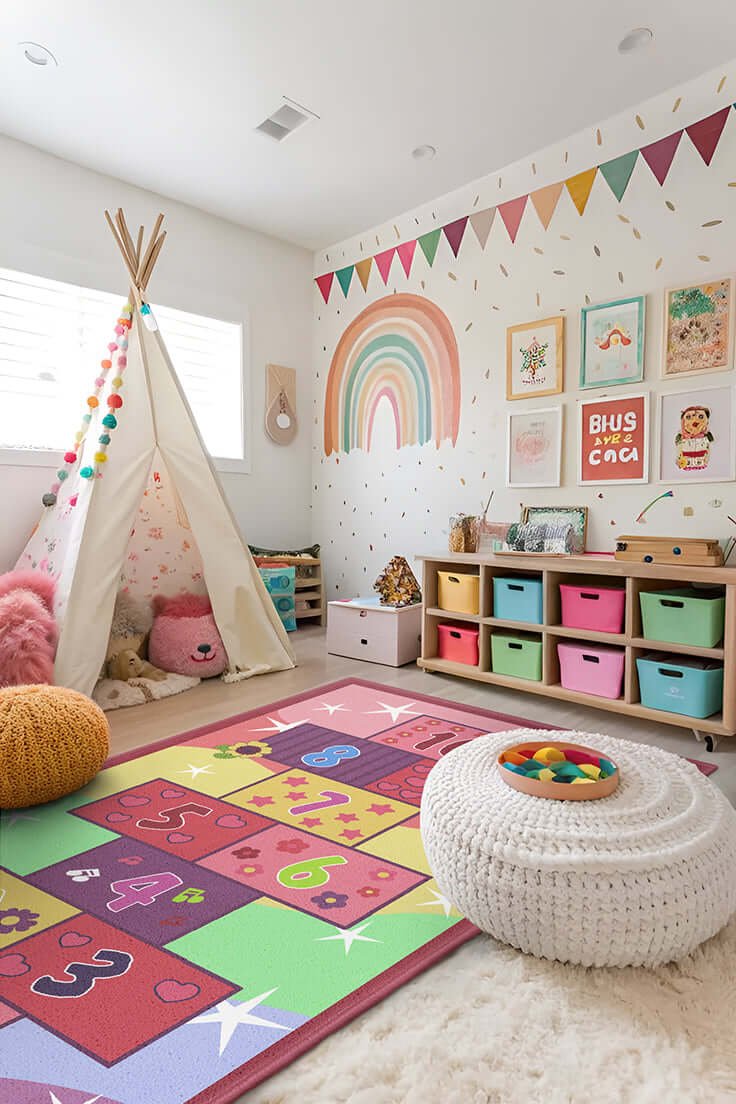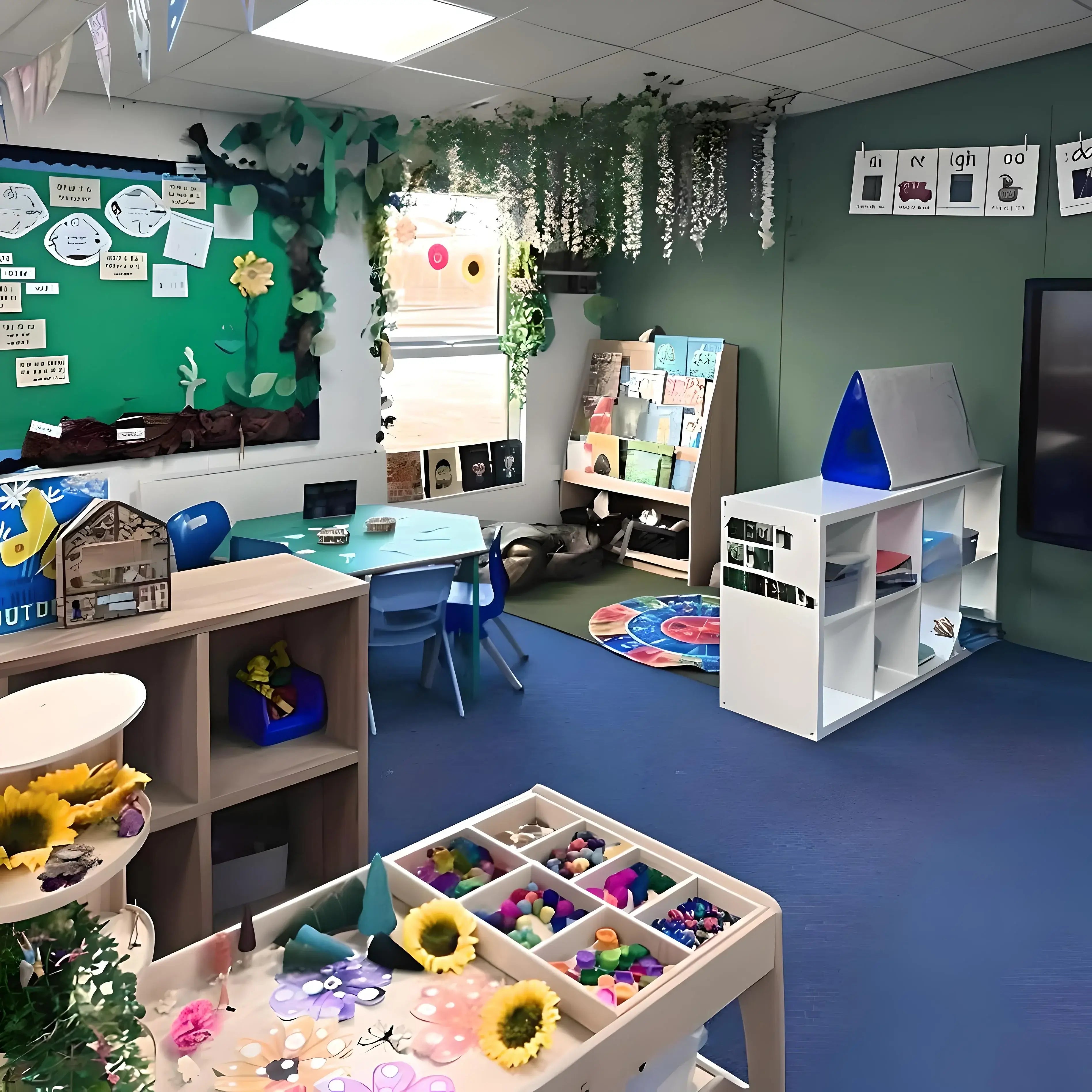Understanding Universal Design for Learning
UDL principles recognize that students learn differently and require various pathways to access, engage with, and demonstrate their understanding of educational content.
The framework emphasizes removing learning barriers while maintaining high academic standards for all students.
Classroom rugs naturally align with these principles by offering flexible, multi-sensory learning opportunities.
According to the Center for Applied Special Technology (CAST), the organization that developed UDL, environmental modifications like specialized seating areas significantly improve learning outcomes for students with diverse needs.
Strategic use of classroom floor spaces creates zones that accommodate different learning preferences and physical requirements.
UDL Principle 1: Multiple Means of Engagement
Creating Motivating Learning Environments
Classroom rugs support student engagement by transforming sterile floor space into inviting, comfortable areas that naturally draw learners together.
The soft texture and designated boundaries create psychological safety, encouraging hesitant students to participate in group activities and discussions.
Accommodating Sensory Preferences
Students with sensory processing differences benefit from the tactile input provided by various rug textures.
Some learners require deep pressure stimulation, while others need soft surfaces to regulate their sensory systems. Quality classroom rugs with different pile heights and materials address these diverse sensory needs.
Supporting Social-Emotional Learning
Circle time activities on classroom rugs foster community building and emotional regulation skills.
Students practice turn-taking, active listening, and empathy while seated together in a non-threatening environment that promotes equal participation.
UDL Principle 2: Multiple Means of Representation
Visual Learning Support
Educational rugs featuring alphabets, numbers, maps, or geometric patterns provide constant visual references that support content comprehension.
These embedded learning tools help students with visual processing strengths access information through multiple channels simultaneously.
Spatial Learning Opportunities
Three-dimensional learning becomes possible when students use rug spaces for kinesthetic activities.
Mathematical concepts like number lines, geometric shapes, and data visualization take on physical dimensions that support spatial learners who struggle with abstract representations.
Multi-Sensory Information Processing
Combining visual rug designs with tactile experiences and auditory instruction creates rich learning environments that accommodate various information processing styles. Students can see patterns, feel textures, and hear explanations simultaneously.
UDL Principle 3: Multiple Means of Expression
Alternative Assessment Opportunities
Classroom rugs provide spaces for performance-based assessments where students can demonstrate understanding through movement, manipulation of objects, or collaborative presentations.
These alternatives benefit learners who struggle with traditional paper-and-pencil tests.
Flexible Communication Options
Some students express themselves better in informal, comfortable settings. Rug areas create opportunities for verbal discussions, peer teaching, and collaborative problem-solving that allow diverse communication styles to flourish.
Accommodating Physical Differences
Students with mobility challenges, attention differences, or other physical needs can access learning more effectively when classroom rugs provide alternative seating options.
Floor-level activities accommodate wheelchairs, allow for movement breaks, and support various positioning needs.
Selecting UDL-Compliant Classroom Rugs
Size and Configuration Considerations
Inclusive classroom rugs should accommodate the full range of student needs in your classroom.
Consider students who use mobility devices, require extra personal space, or benefit from specific positioning.
Modular rug systems offer flexibility to reconfigure spaces as needs change throughout the year.
Texture and Material Diversity
Different students have varying sensory preferences and needs. Some require smooth, low-pile surfaces, while others benefit from textured materials that provide sensory input.
Inclusive classroom furniture selection should consider these individual differences.
Educational Design Elements
UDL-aligned rugs incorporate learning supports directly into their design. Look for features like:
- High-contrast colors for students with visual impairments
- Tactile elements that support braille readers
- Clear organizational sections for students who need structure
- Culturally responsive imagery that reflects student diversity
Implementation Strategies for Inclusive Learning
Establishing Flexible Usage Guidelines
Create classroom norms that respect different learning needs while maintaining structure.
Some students may need to stand or move during rug activities, while others require consistent seating positions. Flexible seating arrangements support these diverse needs.
Providing Choice and Voice
Allow students to select their positions on the rug based on their individual needs and preferences. This self-advocacy practice builds independence while ensuring comfortable learning experiences for all participants.
Incorporating Universal Supports
Use visual schedules, clear expectations, and consistent routines during rug activities to support students with autism, ADHD, or other learning differences. These proactive supports benefit all learners, not just those with identified needs.
Benefits for Diverse Learners
Students with Learning Disabilities
Classroom rugs provide alternative learning venues where students can process information through multiple senses.
The informal setting often reduces anxiety and allows better focus for learners who struggle in traditional desk arrangements.
English Language Learners
Visual supports embedded in educational rugs help ELL students access content while developing language skills.
Collaborative rug activities provide natural opportunities for peer interaction and language practice in low-pressure environments.
Students with Autism Spectrum Disorders
Predictable rug routines and clearly defined spaces support students who benefit from structure and consistency. The sensory input from carpet textures can have calming effects for students with sensory processing differences.
Gifted and Advanced Learners
Flexible rug spaces accommodate extended discussions, creative problem-solving, and peer teaching opportunities that challenge advanced learners while building leadership skills.
Creating Inclusive Learning Activities
Multi-Modal Instruction
Design rug activities that simultaneously engage visual, auditory, and kinesthetic learning channels.
Story time might include visual props, sound effects, and movement activities that allow all students to access the content through their preferred modalities.
Collaborative Learning Structures
Use cooperative learning strategies during rug activities that leverage student strengths while supporting areas of need. Peer partnerships can provide natural supports without stigmatizing individual differences.
Assessment Alternatives
Develop rubrics that allow students to demonstrate learning through various means during rug activities.
Some students might show understanding through verbal explanations, while others use drawings, demonstrations, or collaborative projects.
Addressing Common Implementation Challenges
Budget Considerations for Inclusive Design
Invest in quality rugs that will accommodate diverse needs over time. While initial costs may be higher, UDL-compliant classroom rugs serve more students effectively and require fewer modifications or replacements.
Professional Development Needs
Teachers need training to effectively implement UDL principles through environmental modifications. Understanding how classroom rugs support diverse learners requires knowledge of disability awareness, sensory processing, and inclusive pedagogy.
Space Limitations and Creative Solutions
Small classrooms can still incorporate UDL principles through strategic rug placement and multi-purpose design. Consider rugs that can be easily moved or stored when not in use, maximizing flexibility in limited spaces.
Measuring Success in Inclusive Environments
Student Engagement Indicators
Monitor participation rates, on-task behavior, and self-advocacy skills during rug activities. Increased engagement across diverse learners indicates successful UDL implementation.
Academic Achievement Across Populations
Track learning outcomes for all student subgroups to ensure that universal learning design modifications benefit everyone, not just students with identified needs.
Social-Emotional Growth
Assess improvements in peer relationships, communication skills, and classroom community building that often result from inclusive rug activities.
Future Directions in Inclusive Classroom Design
Technology Integration for Accessibility
Emerging assistive technologies can enhance rug-based learning experiences for students with disabilities. Audio descriptions, tactile feedback systems, and customizable visual displays expand access for diverse learners.
Research-Based Improvements
Ongoing research in neuroscience and learning differences continues to inform best practices for inclusive classroom environments. Stay current with evidence-based strategies for supporting diverse learners through environmental modifications.
Conclusion
Universal Design for Learning principles transform classroom rugs from simple floor coverings into powerful tools for inclusion and accessibility.
When thoughtfully selected and implemented, these versatile learning spaces accommodate the full spectrum of student needs while maintaining high expectations for all learners.
The investment in UDL-compliant classroom rugs pays dividends through improved engagement, academic achievement, and social-emotional growth across diverse student populations.
As education continues embracing inclusive practices, classroom rugs represent an accessible, cost-effective strategy for creating learning environments where every student can succeed.
By applying UDL principles to classroom rug selection and usage, educators demonstrate their commitment to equity and inclusion while providing practical supports that benefit all learners.
The result is a classroom community where differences are celebrated, strengths are leveraged, and every student has the opportunity to reach their full potential.




Leave a comment
This site is protected by hCaptcha and the hCaptcha Privacy Policy and Terms of Service apply.